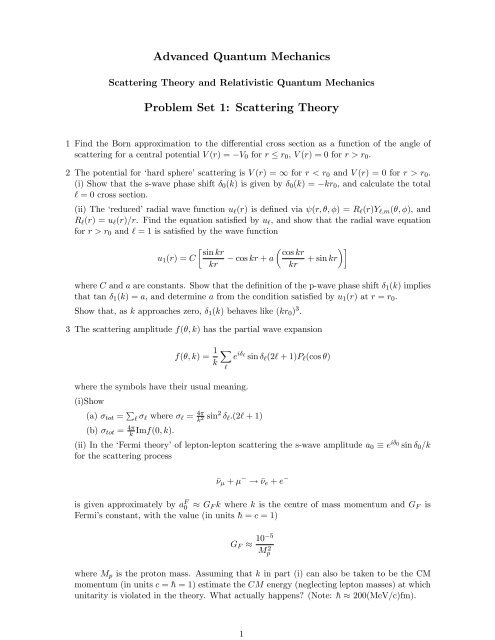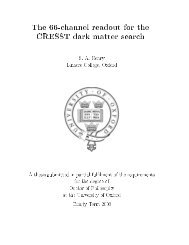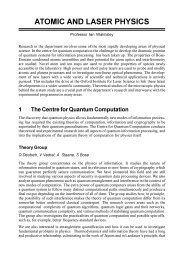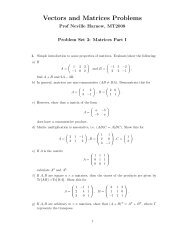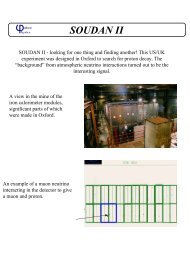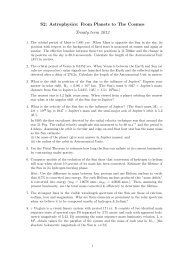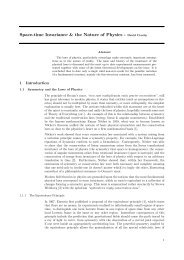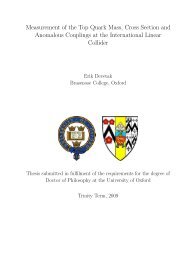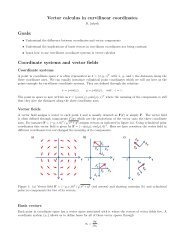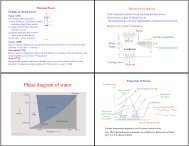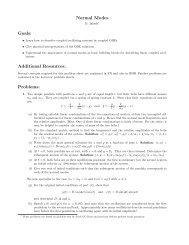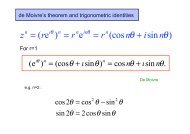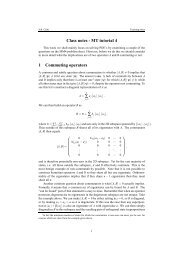Advanced Quantum Mechanics Problem Set 1: Scattering Theory
Advanced Quantum Mechanics Problem Set 1: Scattering Theory
Advanced Quantum Mechanics Problem Set 1: Scattering Theory
You also want an ePaper? Increase the reach of your titles
YUMPU automatically turns print PDFs into web optimized ePapers that Google loves.
<strong>Advanced</strong> <strong>Quantum</strong> <strong>Mechanics</strong><br />
<strong>Scattering</strong> <strong>Theory</strong> and Relativistic <strong>Quantum</strong> <strong>Mechanics</strong><br />
<strong>Problem</strong> <strong>Set</strong> 1: <strong>Scattering</strong> <strong>Theory</strong><br />
1 Find the Born approximation to the dierential cross section as a function of the angle of<br />
scattering for a central potential V (r) = V 0 for r r 0 , V (r) = 0 for r > r 0 .<br />
2 The potential for `hard sphere' scattering is V (r) = 1 for r < r 0 and V (r) = 0 for r > r 0 .<br />
(i) Show that the s-wave phase shift 0 (k) is given by 0 (k) = kr 0 , and calculate the total<br />
` = 0 cross section.<br />
(ii) The `reduced' radial wave function u`(r) is dened via (r; ; ) = R`(r)Y`;m (; ), and<br />
R`(r) = u`(r)=r. Find the equation satised by u`, and show that the radial wave equation<br />
for r > r 0 and ` = 1 is satised by the wave function<br />
sin kr<br />
u 1 (r) = C<br />
kr<br />
<br />
cos kr<br />
cos kr + a + sin kr<br />
kr<br />
where C and a are constants. Show that the denition of the p-wave phase shift 1 (k) implies<br />
that tan 1 (k) = a, and determine a from the condition satised by u 1 (r) at r = r 0 .<br />
Show that, as k approaches zero, 1 (k) behaves like (kr 0 ) 3 .<br />
3 The scattering amplitude f(; k) has the partial wave expansion<br />
where the symbols have their usual meaning.<br />
(i)Show<br />
f(; k) = 1 X<br />
e i` sin `(2` + 1)P`(cos )<br />
k<br />
`<br />
(a) tot = P` ` where ` = 4 sin 2 `:(2` + 1)<br />
k 2<br />
(b) tot = 4 k<br />
Imf(0; k).<br />
(ii) In the `Fermi theory' of lepton-lepton scattering the s-wave amplitude a 0 e i 0<br />
sin 0 =k<br />
for the scattering process<br />
+ <br />
! e + e<br />
is given approximately by a F 0 G F k where k is the centre of mass momentum and G F is<br />
Fermi's constant, with the value (in units h = c = 1)<br />
G F 10 5<br />
M 2 p<br />
where M p is the proton mass. Assuming that k in part (i) can also be taken to be the CM<br />
momentum (in units c = h = 1) estimate the CM energy (neglecting lepton masses) at which<br />
unitarity is violated in the theory. What actually happens? (Note: h 200(MeV/c)fm).<br />
1
4 L x is a linear ordinary dierential operator and (x) satises the equation L x (x) = g(x)<br />
where g(x) is a known function. The functions n (x) form a complete orthonormal set of<br />
eigenfunctions of L x , with eigenvalues n :<br />
L x n (x) = n n (x):<br />
Expanding (x) as a linear combination of the n (x) via<br />
(x) = X n<br />
a n n (x);<br />
show that<br />
a m = 1<br />
m<br />
Z<br />
m(y)g(y)dy:<br />
Deduce that the Green function for the equation L x = g must be<br />
G(x; y) = X n<br />
n (x) n(y)<br />
n<br />
= X n<br />
hxjni hnjyi<br />
n<br />
:<br />
Verify that this is correct by applying the operator L x to G(x; y).<br />
Use this approach to nd the coordinate space Green function for the time independant<br />
Schrodinger equation.<br />
5 (i) In rst order time-dependent perturbation theory, the transition probability per unit time<br />
for a particle in the momentum eigenstate j k i i to scatter, via the time-independent potential<br />
V (r), into the momentum eigenstate j k f i is<br />
Z<br />
2 j hk f j V j k i i j 2 (E i<br />
E f ) d3 k f<br />
(2) 3<br />
where units h = 1 are used (for a concise derivation see P79, Quarks and Leptons, Halzen &<br />
Martin, Wiley 1984). Writing<br />
d 3 k f =j k f j 2 d j k f j d and E f = k 2 f =2m<br />
show that d 3 k f = m j k f j dE f d, and hence show that the dierential cross section is<br />
d<br />
d = m2<br />
4 2 j hf j V j ii j2 :<br />
(ii) Show that<br />
Z<br />
e<br />
iqr e<br />
r=a<br />
d 3 r =<br />
r<br />
4<br />
q 2 + a 2 :<br />
By considering the limit a ! 1, derive the Rutherford scattering cross section formula<br />
d<br />
=<br />
d R<br />
h 2 c 2 2<br />
16E 2 sin 4 =2<br />
using Born Approximation for the Coulomb potential for two charges, one +e and one e;<br />
here E = 1 2 mv2 where v is the speed of the incoming particle and m is its mass; also, is the<br />
ne structure constant and is the scattering angle (ie the angle between the incident wave<br />
vector and the nal wave vector).<br />
2


